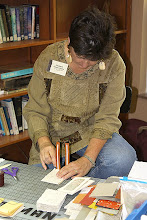Since the ITV television show,
Doc Martin is filmed in Port Isaac, Cornwall, we decided to drive along the north coast to the 14th c. village to take a few photos on location. What we discovered when we arrived was the cast and crew shooting Series Five!
 |
| Television crew's vehicles on the beach in the harbor in Port Isaac |
Port Isaac, known as Port Wenn on the TV show, is a working fishing village on the northern, Atlantic coast of Cornwall. We arrived before lunch with plans to take a few photos for Pat Vivod, who is not only an amazing textile artist through organic printing and dyeing (see her blog
Sentimental Pentimento), she is a devoted Doc Martin fan. While Pat was in a workshop in St. Louis with
India Flint learning even more about the chemistry of organic dyeing, we decided to travel on a quest for Doc Martin on Pat's behalf with one of her silk scarves in the starring role. Since much of my work in handmade paper is influenced by the textures and colors of Cornwall, it is easy to see why I purchased this scarf (below) from Pat's collection. See if you can find it in the photos as it travelled through the village.
 |
| The Pat Vivod silk scarf on beach pebbles |
It was obvious that Port Isaac residents and guests knew that the television crew was shooting all week, yet the mood was very laid back about the experience. For example, the crew had prepared three or four small vignettes outside businesses which included a handwritten sign informing us that the leeks, beautifully displayed outside the green grocer's (actually an art gallery), were not for sale. As people walked by the display, we repeatedly saw women reach for the leeks, read the sign, then tell their friends, "Too bad it's for filming, they are such lovely leeks!"
 |
| Film set of "green grocer" outside a real art gallery (scarf in basket) |
 |
| Film set of "green grocer" looking down street towards harbor |
By the time we walked through very narrow streets and reached the harbor wall, we learned that the crew was currently shooting outside the "Large Restaurant" (actually a private home) above the cliffs along the harbor wall.
 |
| "Large Restaurant,"center home above rock cliffs along harbor wall |
 |
Lunch scene from Series Five (Martin Clunes and Caroline Catz sitting at table;
Ian McNeice standing) |
Martin Clunes (Doc Martin) , Caroline Catz (Louisa Glasson) and Ian McNeice (Bert Large), along with a variety of extras were in the scene. Since it actually was lunchtime, filming stopped for everyone to eat, which gave us the chance to pop into the Golden Lion, often used as a set during Series One, for a pint and a ploughman for Peter and a zucchini & stilton pastie for me.
After lunch, we walked the cliff path above where the filming had resumed to get a closer look at the crew through the garden gate. This also gave us the opportunity to photograph "Doc Martin's house" on the show - the third cottage up the path on the left.
While the show's audio tech could probably eliminate most background sounds from the beach below the "restaurant" set, each time a fishing boat returned, all production ceased until the boats had put down anchor and off loaded their cargo.
Filming the lunch scene took more than three hours before the director called cut and gave a thumbs up to the crew waiting on the harbor beach below. Because
Doc Martin is not a period piece, it was almost impossible to tell the locals from the actors as they walked through the village to the next location at the "Port Wenn Cobbler."
 |
| Caroline Catz (Louisa Glasson on show) and Martin Clunes (Doc Martin) finished with lunch scene |
 |
| Caroline Catz (Louisa Glasson on show) walking past Aquarium |
Having no idea how long it might take to prepare the next scene, we walked back up the hill towards our car, past the Cobbler set. Suddenly, we realized the teenage girls and the gentleman pushing the pram surrounding us were not locals or tourists, but extras in the next scene. Not knowing how long it might take before filming began again, I decided to pop into a shop while the director talked to the crew and extras. Little did we know we would soon have the chance to meet one of the main actors.
Read Quest for Doc Martin - Part 2 for the next in the Series!










